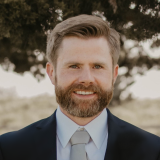Oklahoma Bar Journal
Long-Term Care Planning for Oklahoma's Farmers and Ranchers
By Tyler R. Barrett

maxbelchenko | #466339146 | stock.adobe.com
According to government estimates, 70% of adults who survive to the age of 65 will receive some form of long-term care before death.[1] That care does not come cheap. In 2021, the annual median cost of a home health aide in Oklahoma exceeded $58,000; the cost of a semi-private room in a nursing home facility was over $65,000.[2]
Given these figures, incapacity can derail even the most well-thought-out estate plans. And the risk is more acute for certain types of clients. One such client is the farmer and rancher.
Oklahoma ranks fourth in the nation for number of farms, and our state exports $1.8 billion in agricultural products every year.[3] While farming is big business, it continues to be a family one: upwards of 97% of farms are family owned.[4] And many of these farms have been in the family for ages, conceivably even dating to the Land Run of 1889. Estate planning for farmers and ranchers thus entails both great opportunities as well as considerable risk. Many practitioners rightfully focus on tax minimization, fiduciary selection and distribution to the next generation. Frequently overlooked, though, is the possibility that the family patriarch or matriarch will become incapacitated – a ticking time bomb with the potential to derail a legacy built through decades of toil and perseverance.
WHY LONG-TERM CARE PLANNING IS CRITICAL FOR FARMERS AND RANCHERS
Oklahoma’s beloved Will Rogers once quipped: “The farmer has to be an optimist, or he wouldn’t still be a farmer.” Agriculture is not only hard work but also is subject to a larger number of variables than almost any other industry. The weather. Commodity prices. Recessions. International conflicts (e.g., Russia’s invasion of Ukraine). For the family farmer, it all matters. If that were not enough, agriculture is extremely cost-intensive, particularly in times of higher inflation. Total expenditures by U.S. farms – not including Hawaii and Alaska – reached $452.7 billion in 2022, a 15.2% increase from the previous year.[5]
As they would tell you, our state’s farmers and ranchers operate on tight margins. How is this relevant to estate and long-term care planning? It is not unusual for family-owned farms to carry values in the millions of dollars – if not tens of millions of dollars – representing the bulk of the client’s net worth. Yet, owing to their high operating costs, the agribusiness client might lack the liquidity to absorb long-term care expenses in the event of incapacity.
What’s more, owners of family businesses tend to prioritize succession planning. These clients may have a child who works in the business and is slated to one day assume ownership and control of it. However, if the client ends up in a nursing home, the family could be faced with selling the farm to pay for it. One option is long-term care insurance. Unfortunately, long-term care insurance is outside the reach of many clients stemming from age or health conditions.
Luckily, with careful planning, we can still help our farming and ranching clients avoid the worst-case scenario. Although each situation is unique, clients typically have a seemingly contradictory objective of safeguarding assets while retaining management, custody and control of them. As we will see, there is a way to bridge that gap.
IRREVOCABLE TRUSTS: A TIME-TESTED TOOL FOR PROTECTING ASSETS FROM LONG-TERM CARE
Traditionally, estate planning and elder law attorneys have utilized irrevocable trusts to protect assets from long-term care expenses. The reason? They work! If designed properly, irrevocable trusts are largely unreachable by creditors. Significantly, irrevocable trusts can also position the client to qualify for Medicaid and/or veteran’s benefits. With these goals in sight, the trust must possess a few key features.
First, it should be irrevocable because a revocable living trust will not adequately protect the assets for the following reasons. Revocable living trusts offer no creditor protection for the grantor. That is because a revocable living trust allows the grantor to alter, amend or revoke the instrument. Likewise, Oklahoma law is clear that the principal of a revocable living trust is an available resource to the grantor for Medicaid purposes.[6] So, while a revocable living trust offers other benefits like probate avoidance, they are ineffective in Medicaid planning.
Second, trusts designed to insulate assets from long-term care expenses must forbid the grantor from accessing the corpus (or principal) of the trust. The Oklahoma Administrative Code, which contains our state’s Medicaid eligibility rules, provides as follows:
In the case of an irrevocable trust, if there are any circumstances under which payments from the trust could be made to or for the benefit of the individual, the portion of the principal of the trust, or the income on the principal, from which payment to the individual could be made is considered available resources. Payments from the principal or income of the trust is considered income of the individual. Payments for any other purpose are considered a transfer of assets by the individual and are subject to the sixty (60) months look back period. Any portion of the trust from which, or any income on the principal from which no payment could under any circumstances be made to the individual is considered as of the date of establishment of the trust (or if later, the date on which payment to the individual was foreclosed) to be assets disposed by the individual for purposes of the asset transfer rules and are subject to the 60 months look back period.[7]

Nina L/peopleimages.com | #596701407 | stock.adobe.com
Mindful of the “any circumstances test,” the careful drafter will prohibit the trustee from electing unitrust status or adjusting between income and principal. The trust instrument should further restrict principal distributions to the grantor’s spouse. In Daily v. State ex rel. Oklahoma Dept. of Human Services, the Oklahoma Court of Civil Appeals considered an irrevocable trust wherein the grantor’s wife received all the net income and principal of the trust in 48 monthly installments.[8] Any funds remaining in trust at the wife’s death were to be distributed according to her will. The Daily court held that the entire trust was a countable resource for the grantor’s Medicaid eligibility.[9]
Finally, to prevent an argument that the grantor can alter the trust, neither the grantor nor their spouse should serve as a trustee. The author is unaware of any reported cases in Oklahoma denying Medicaid eligibility on this basis. Nevertheless, in dealing with Medicaid, it is prudent to exercise caution.
BEWARE THE FAMILY DYNAMICS
Apart from satisfying technical legal requirements, a skillful planner will contemplate the family dynamics. Does everyone get along? Are the client’s decision-makers capable and reliable? How comfortable is the client in relinquishing control? It is this last factor that calls for additional planning tools beyond irrevocable trusts. For reasons both personal and practical, agribusiness clients will likely seek to maintain at least some control over the family farm and its operations. In a lot of instances, the kids are too young or inexperienced to assume managerial responsibilities. Crop subsidies and tax breaks might be lost if the farm is transferred to an irrevocable trust. And due to their rigidity, irrevocable trusts are usually poorly suited to operating a business. Accordingly, one should consider coupling an irrevocable trust with a family limited liability company.
THE USE OF FAMILY LIMITED LIABILITY COMPANIES IN LONG-TERM CARE PLANNING
Most of us are familiar with the limited liability company structure. Maybe you set one up for a client with rental properties. Perhaps your own law firm is an LLC. Why have an LLC? Two words: asset protection. Under Oklahoma law, a charging order is the exclusive remedy available to an LLC member’s judgment creditor.[10] As a result, the judgment creditor has only the rights of an assignee and cannot obtain a membership interest in the LLC or pursue a foreclosure.[11]
A family limited liability company (FLLC) is simply an LLC formed by members of the same family to operate a business, which, in our example, is a farm. To begin with, the client would transfer the farm to the FLLC. The FLLC is, in turn, owned by the client’s irrevocable trust.[12] Because the client has no right to invade the principal of the irrevocable trust or serve as its trustee, the FLLC membership interest is, therefore, uncountable for Medicaid purposes. The FLLC operating agreement governs management of the farm. The client wishing to retain control would name themselves as manager of the FLLC. Additionally, the client can engage in succession planning by designating successor managers and including provisions like rights of first refusal to increase the likelihood of the farm staying in the family following the client’s death. Lastly, to ensure that the client can continue living on the farm, the irrevocable trust should include a right of occupancy for the client/grantor.[13]
OTHER CONSIDERATIONS: THE FIVE-YEAR LOOKBACK
Preferably, clients would request our counsel on asset protection and long-term planning when they are healthy and young. But we know that does not always happen. The planning described above is most effective well in advance of the client applying for Medicaid. That is because, in addition to determining whether a Medicaid applicant meets the income and asset guidelines,[14] the Oklahoma Department of Human Services (OKDHS) looks back five years to see if the applicant has made any uncompensated transfers of assets. If so, OKDHS can delay the applicant’s benefits for a period of months or even years, depending on the amount transferred.[15]
How, then, do we help the client who has an imminent need for care? Of most relevance to the instant topic is the use of promissory notes. In Lemmons v. Lake, plaintiff sold her farm (as well as an Edward Jones account) to her son in exchange for a promissory note.[16] Twelve days later, the plaintiff applied for Medicaid benefits – which OKDHS denied. Finding for the plaintiff, the United States District Court held that a promissory note was neither a countable resource for Medicaid eligibility nor a violation of the rules pertaining to uncompensated transfers so long as the note: 1) has an actuarially sound repayment term, 2) provides for equal payments with no balloon or deferral payments and 3) prohibits cancellation of the note upon the death of the lender.
While Oklahoma case law supports certain crisis planning tools, such as promissory notes, the limitation of this strategy is significant. For one thing, the client’s children often lack the financial means to make continuing payments on the note. Worse yet, the client loses control of the assets transferred pursuant to the note. If established in advance of incapacity, an irrevocable trust and family limited liability avoid these outcomes.
PLANNING AHEAD TO PRESERVE A LEGACY
Among the hardest conversations are those in which we confront our own mortality. By shifting the discussion to legacy, we illustrate to our clients how planning can be an opportunity and not a burden. And using the right tools, we can help our clients honor their values, their life’s work and the land that we all love.
 ABOUT THE AUTHOR
ABOUT THE AUTHOR
Tyler R. Barrett is the founder and attorney at The Law Office of Tyler R. Barrett PLLC in Norman. Mr. Barrett’s practice focuses on estate planning and asset protection, elder law and probate and trust administration. He is a 2011 graduate of the OU College of Law, where he served as an articles editor for the Oklahoma Law Review.
ENDNOTES
[1] U.S. Department of Health and Human Services, “What is the Lifetime Risk of Needing and Receiving Long-Term Services and Support,” available at https://bit.ly/3TH3JoK.
[2] Genworth 2021 Cost of Care Survey, available at https://bit.ly/3tFBewX.
[3] Oklahoma Department of Agriculture, “Agribusiness Quick Facts,” https://bit.ly/48CR9Lp.
[4] Oklahoma Farm Bureau, “Family Farms,” available at https://okfbfoundationforagriculture.org/family-farms/.
[5] United States Department of Agriculture, U.S. Farm Production Expenditures 2022, available at https://bit.ly/47lSoxC.
[6] OAC 317:35-5-41.6(5)(c)(ii).
[7] OAC 317:35-5-41.6(5)(c)(ii) (emphasis added).
[8] 2009 OK CIV APP 107, 228 P.3d 1199.
[9] Id.
[10] 18 O.S. §2034.
[11] Id. Some commentators have suggested that charging order protection is illusory as to single-member LLCs. See Steven P. Cole, “Charging Order Protection for a Single Member LLC May Still be Illusory,” OBJ Vol. 81, No. 7 (2010). However, if that sole member is an irrevocable trust – itself also protected from creditors – the author believes these concerns are mitigated.
[12] The irrevocable trust should contain provisions permitting it to own closely held business interests.
[13] When drafting the right of occupancy, the attorney must exercise great care so that it is not deemed to be a life estate, which are a countable resource under Oklahoma’s Medicaid rules. See OKDHS 10-1-5(d)(1), available at https://bit.ly/41Q60jl.
[14] As of the date of this article, a single applicant must have less $2,000 in countable assets and $6,833 in monthly income. See OKDHS Appendix C-1, available at https://bit.ly/48KkwLX.
[15] See OAC 317:35-19-20(5).
[16] Case No. CIV-12-1075-C (W.D. Okla. March 21, 2013).
Originally published in the Oklahoma Bar Journal – OBJ 95 No. 2 (February 2024)
Statements or opinions expressed in the Oklahoma Bar Journal are those of the authors and do not necessarily reflect those of the Oklahoma Bar Association, its officers, Board of Governors, Board of Editors or staff.
